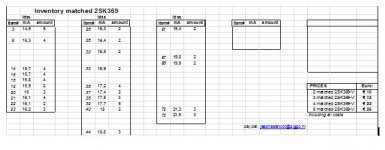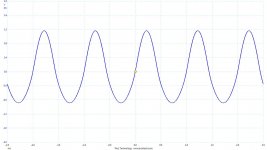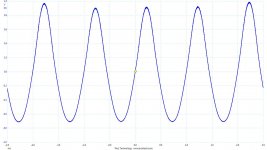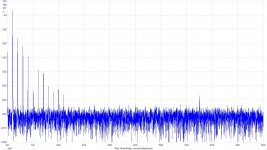Hi
I should have said "this version of Sen". I think that sbelyo was asking whether it was OK to use a dual mono Buffalo with the version proposed- and used very happily by many, including me- for a stereo Buffalo.
But I'm glad I didn't, as thanks to Patrick I've know learnt about alternatives which should suit the ESS1038! One thing though- what kind of batteries should one choose if NiMH types struggle to give sufficiently long operation before recharging? Lithium?
Paul N
Apparently the new ESS1038, to be used in buffalo 4, has a much higher output current level, too much for Sen, or Legato or Ivy for that matter. Russ has designed a completely new I/V stage to cope.
I should have said "this version of Sen". I think that sbelyo was asking whether it was OK to use a dual mono Buffalo with the version proposed- and used very happily by many, including me- for a stereo Buffalo.
But I'm glad I didn't, as thanks to Patrick I've know learnt about alternatives which should suit the ESS1038! One thing though- what kind of batteries should one choose if NiMH types struggle to give sufficiently long operation before recharging? Lithium?
Paul N
kudos to Patrick
BTW did you already made that cascoded bf862 SEN - any Impression about sound - which Is dac you use with
Tested prototype.
The DAC is a discrete, balanced version of the Signalyst DSC1 i.e. the DSC2... The digital side is discrete DSD, SMD and clock optimized. The analog board incorporates the SEN I-V feeding the Wurcer Discrete OP Amp http://www.diyaudio.com/forums/anal...screte-opamp-open-design-156.html#post3192755 (which also employs the BF862 and which is also cascoded) as the basis of a 4 pole SK filter. http://www.diyaudio.com/forums/digital-line-level/254935-signalyst-dsc1-45.html#post5000000
The analog board is mirrored.
I know that I have to add components to the V18 boards to get it to work with the BIII but from what I under stand when you put the BIII in dual mono mode it parallels the dacs in the chip so I shouldn't need more that two V18 eval boards correct? Or di I have to change values in the ess9018 scematic?
A dual mono BufIII will output 16mA per Iout. Your bias will need to be around 64mA allowing for only 25% swing. I see in the DIYAudio store a "D" grade LSK170/LSJ74 can be as high as 30mA Idss so you could try a matched pair k170/j74 per channel for CEN (can the XEN sinks work for this?) or more reasonably find a quad of 16mA Idss for which you can then use the boards as is, if available. The Riv will probably need to be lowered (perhaps 100Ω), but you will have the benefit of an even lower Zout.
Last edited:
The batteries are not matched and may not different capacities.
So in order to avoid one of them being over-discharged, it is normal practice to charge them individually.
Common practice for model making people.
In fact, for lithium batteries, there are special ICs widely available for precisely that purpose.
Patrick
So in order to avoid one of them being over-discharged, it is normal practice to charge them individually.
Common practice for model making people.
In fact, for lithium batteries, there are special ICs widely available for precisely that purpose.
Patrick
Why charging them individually? You mean each phase or each battery?
D
The Dual Bank power supply design that I posted was developed for precisely the needs of having multiple floating supplies using either supercaps and/or batteries. For batteries, the MOSFET relays disconnect the batteries and charge individually and then connect in series for supply. Neither of the dual banks are ever intended to be drained more than 10%.
SEN - CEN IV board and parts
Me too!
Thank you
Hello, I was wondering if I could still get the boards and parts for the SEN IV somewhere? Thank you!
Me too!
Thank you
There must be something I am doing wrong: I have a sen for the ESS9018. The sen has 4 2sk369 and drains 44mA. Riv is 400 ohm. I get 0.6V signal with 3% distortion. The sen is fed with 16.2 V batteries. Vref is around 1.6V.
Any hint ?
D.
Can you post pictures on how everything is connected? It will make it easier too see if anything is different from our working builds.
The Dual Bank power supply design that I posted was developed for precisely the needs of having multiple floating supplies using either supercaps and/or batteries. For batteries, the MOSFET relays disconnect the batteries and charge individually and then connect in series for supply. Neither of the dual banks are ever intended to be drained more than 10%.
can you please post link to that
Did you scope it?
Gate stoppers?
Cap over I/V resistor?
Nick
which Is your preffered cap for I/V
can you please post link to that
http://www.diyaudio.com/forums/power-supplies/302881-dual-bank-floating-supercap-supply.html
<JAB.R>
Did you scope it?
Gate stoppers?
Cap over I/V resistor?
No IV cap, stoppers 100 ohm. It's visible by eye that the sine is distorted.
D.
Attachments
- Home
- Source & Line
- Digital Line Level
- Zen -> Cen -> Sen, evolution of a minimalistic IV Converter




